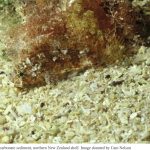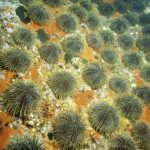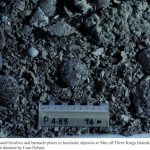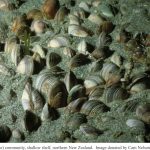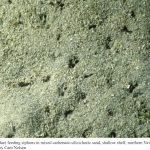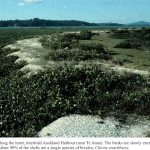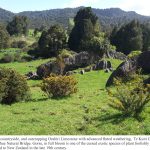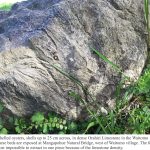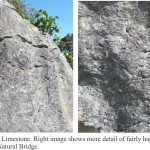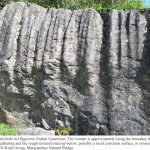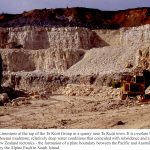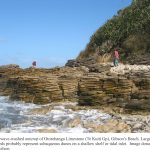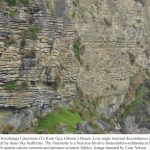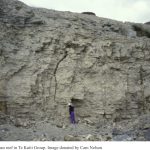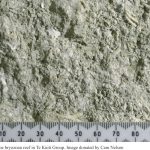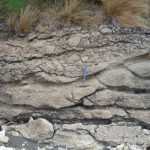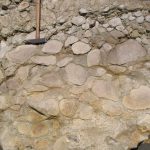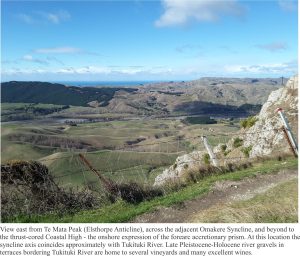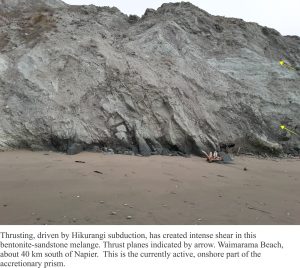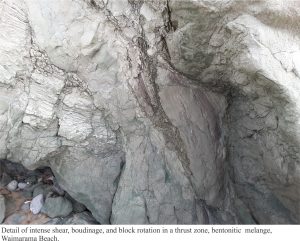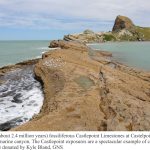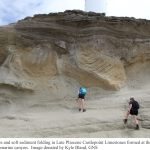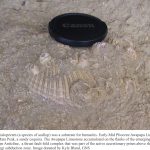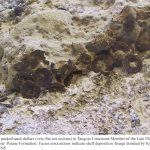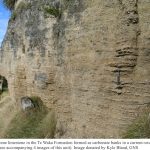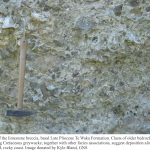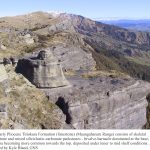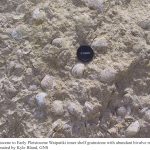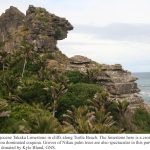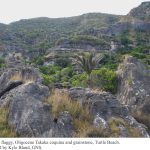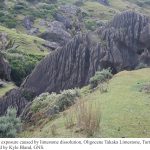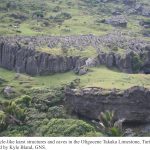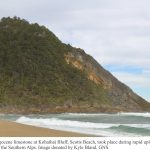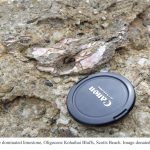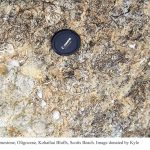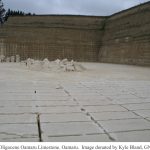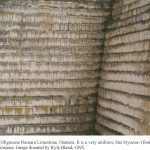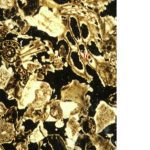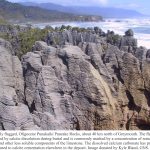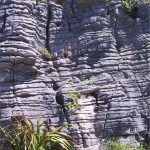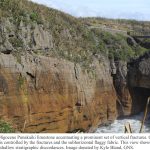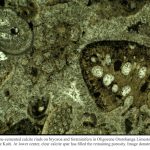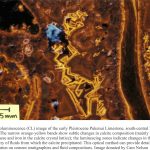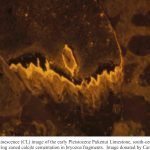For decades, all limestones were thought of as belonging to tropical realms: coral reefs, carbonate platforms, and sabkhas. Beginning in the 1970s, examples of non-tropical carbonates were published, although not always without a bit of pushing and shoving – not all adherents to the tropical paradigm were willing to give up their dominance. In New Zealand, Cam Nelson’s (Auckland and Waikato universities) studies of the Te Kuiti Group limestones, showed clearly that the usual components of tropical carbonates were different: hermatypic corals (other than the odd solitary form) and aragonite sediment-producing calcareous algae like Penicillus are absent, there is a predominance of shelly biotas in the carbonate framework, and marine cements generally lack aragonite.
Oceanographic studies of the New Zealand shelf (and elsewhere) revealed good modern analogues to the ancient non-tropical limestones. Bioclasts making up the carbonate sediment included the same groups of molluscs, cirripedes and bryozoa.
The absence of coral reefs meant there were no barriers to open coasts, ocean swells, storm surges, or bottom currents on shelf or platform. In the New Zealand examples, bioclasts are dominated by faunas like bivalves, bryozoa, barnacles, echinoderms, and rhodoliths (calcareous algae that encrust rock fragments and shells). This is particularly the case on shelves with little terrigenous sediment input, such that there is a diverse epifauna. Good examples of this setting occur around New Zealand.
Bioerosion is common on substrates and shells, resulting in fragmentation, for example bivalves that are bored by endolithic sponges. Fragmental debris is transported by bottom currents, tidal inlets and channels, and in places the impact of storm waves, such that bedforms are common – bedforms that are also represented in the Cenozoic rock record of New Zealand. Cements consist predominantly of calcite, including high-magnesian calcite, as rim cements, sparry cements, and micrite; aragonite, a common component of tropical carbonates, is far less common in cool water facies.
The images in this Atlas include (Clicking on the 3 links will take you directly to the category of interest): examples from the New Zealand cenozoic (primarily Oligocene, Miocene and Pliocene), modern shelf carbonates, and petrography
Follow this link to a few published papers of interest
The Atlas, as are all blogs, is a publication. If you use the images, please acknowledge their source as indicated below (it is the polite, and professional thing to do). This category contains my own images, plus images donated by Cam Nelson, one of the original adherents of the Cool Water Carbonate paradigm, setting the scene with his studies of the Oligocene Te Kuiti Group, and Kyle Bland, a past student of Cam’s who did extensive work on the Te Aute limestones and currently works for GNS Science. Individually, we retain copyright of all images presented herein.
This link will take you to an explanation of the Atlas series, the ownership, use and acknowledgment of images. There, you will also find links to the other Atlas categories.
Click on the image for an expanded view, then the ‘back page’ arrow to return to the Atlas.
The images:
modern cool water carbonates
Images donated by Cam Nelson indicated in captions
Modern carbonate sediment accumulations, Three Kings Islands, northernmost New Zealand
Modern and ancient rhodoliths
Three Kings Islands
Examples of the carbonate production ‘factory’, northern New Zealand shelf.
Bivalve substrates, significant bioerosion by boring sponges, northern New Zealand shelf
Sediment producers of modern cool-temperate water carbonates, northern New Zealand
Intertidal carbonate sediment production – shell banks
cenzoic cool water carbonates
Te Kuiti Group limestones, Oligocene to early Miocene, that includes bryozoan reefs and oyster beds. This stratigraphic unit extends over large swaths of Waitomo district. The limestones represent periods of high benthic and epibenthic production in locations devoid of terrigenous sediment input. This was a time in New Zealand’s geological history when much of the landmass had been transgressed by warm seas. It was terminated abruptly in the Early Miocene by tectonics associated with development of the Pacific-Australian plate boundary.
Typical exposures of Te Kuiti Group limestones, with fluted surfaces formed by calcite dissolution.
Oyster beds are one of the main features of the Orahiri Limestone. They were large, very thick shelled, commonly stacked into banks and bars across the shallow shelf-platform.
Details of oyster habit, size, and packing, Orahiri Limestone.
Possible bioerosion and omission surfaces separating stacked oyster banks. Orahiri Formation
Late Oligocene – Early Miocene Otorohanga limestone (Gibsons Beach, west of Te Kuiti town) showing prominent cross bedding.
Bryozoan reefs in the mid-Oligocene Hauturu Limestone
Left: Te Akau limestone breccia, part of the basal Lower Miocene Waitemata Group, in erosional contact with Otorohanga Limestone. The breccia consists of eroded Otorohanga limestone. Dissolution pitting on clast surfaces formed before breccia deposition. The contact is a sequence boundary. Images donated by Cam Nelson.
Te Aute limestones (mostly Pliocene-Pleistocene)
The tectono-stratigraphic setting in which Te Aute limestones (and associated strata) accumulated was wildly different to the relatively stable platform underlying Te Kuiti and other Oligocene limestones. By the end of the Miocene, the plate boundary through New Zealand was fully functioning. Along the Hikurangi segment of the boundary, Pacific Ocean crust was being subducted beneath the Australian Plate. An accretionary prism, dominated by east-verging thrusts, created Miocene and younger sedimentary piggy-back basins, at times contiguous, and at other times disconnected by active faulting and folding. Te Aute limestones were part of this milieu. They accumulated on high energy shelves, along coastlines that in places exposed older bedrock lithologies, and in submarine canyons.
Most of the Te Aute images have been donated by Kyle Bland. I’ve added a few that give a sense of the modern landscape, and the intense deformation that active faulting – the product of subduction and accretionary prism growth – still produces. Check out the references at the bottom of this page for detailed descriptions and interpretations.
Submarine canyon facies, Castlepoint Formation
Various Fragmented and complete skeletal limestone components
Te Waka Limestone, a high energy inner shelf and rocky coast deposit.
Te Waka limestone basal breccia with bedrock fragments derived from rocky embayments and sea stacks.
Mixed carbonate-siliciclastic facies, Titiokura Limestone, Maungaharuru Range
Cross bedded grainstone, soft sediment deformation and biomoulds in Waipataiki Limestone
Takaka Limestone
One of several Oligocene – Early Miocene limestones in the Nelson-Tasman districts of South Island, accumulating in structurally controlled basins prior to uplift of the Southern Alps. It is predominantly a hard bivalve-bryozoa grainstone-coquina, locally stylolitic. Post-uplift exposure resulted in karst landscapes and extensive cave systems (forming locally important aquifers). The examples here are from Turtle Beach along the rugged and wild west coast, Tasman District
Kohaihai Bluff limestone, Scotts Beach
South of the limestones exposed at Turtle Beach (images above), coarse, locally pebbly Oligocene limestones are exposed in a west-dipping hogsback. The limestone is dominated by complete and fragmented bivalves. Tilting of the units took place during rapid uplift and erosion of Southern Alps over the past few million years – uplift of the mountain range in place exceed 10 mm/year.
Oamaru Limestone
This is probably the best known limestone in New Zealand because of its use as building stone. It is a very uniform, bryozoa-dominated, fine-grained Oligocene limestone (90% calcium carbonate). The thin section shows significant intraskeletal porosity. The accompanying thin section shows abundant bryozoa; foraminifera are less common.
Punakaiki limestone
Again on the west coast of South Island, another Oligocene limestone that at its coastal exposures, has formed caverns, caves and blowholes through which west coast swells explode. They are known locally as Punakaiki Pancake Rocks, a popular and at times spectacular tourist destination. The limestones have well developed flags that delimit a myriad stylolites. This strong planar fabric along with well developed vertical fracture sets, lead to the occasional collapse of large blocks – aided by the vibration and transient high fluid pressures generated by the cascading of waves.
Thin sections – petrography
Oligocene Orahiri and Otorohanga limestones, Te Kuiti Group
Oligocene Potikohua Limestone near Greymouth, South Island
Pleistocene limestones, southern North Island, in plain polarized light and cathodoluminescence
Pliocene Te Aute Limestone, biomoulds
Published papers of interest:
CS, Nelson, 1978. Stratigraphy and paleontology of the Oligocene Te Kuiti Group, Waitomo County, South Auckland, New Zealand. New Zealand Journal of Geology & Geophysics, v.21, p 553-594.
JR Pettinga, 1980. Upper Cenozoic structural history, coastal Hawke’s Bay, New Zealand. New Zealand Journal of Geology and Geophysics, 25, 149-191.
CS Nelson, 1988 (Editor). Non-tropical carbonates – modern and ancient. Sedimentary Geology, Volume 60, Issues 1–4, Pages 3-367 – A collection of 24 papers
CS Nelson, PR Winefield, SD Hood, V. Caron, A Pallentine, and PJJ Kamp. 2003. Pliocene Te Aute limestones: Expanding concepts for cool-water shelf carbonates. New Zealand Journal of Geology and Geophysics, 46, 407-424.
V Caron, CS Nelson, and PJJ Kamp. 2004. Contrasting carbonate depositional systems for Pliocene cool-water limestones cropping out in central Hawke’s Bay, New Zealand. New Zealand Journal of Geology and Geophysics, 47, 697-717.
Bland, K.J.; Kamp, P.J.J.; Pallentin, A.; Graafhuis, R.; Nelson, C.S.; Caron, V. 2004 The early Pliocene Titiokura Formation : stratigraphy of a thick, mixed carbonate-siliciclastic shelf succession in Hawke’s Bay Basin, New Zealand. New Zealand Journal of Geology and Geophysics, 47(4): 675-695
M Pedley, G Carannante, (Eds.), 2006. Cool-water carbonate: Depositional systems and Palaeoenvironmental controls. Geological Society of London, Special Publications, 255.
PJJ Kamp, ARP Triparthi, & CS Nelson, 2014 Paleogeography of Late Eocene to earliest Miocene Te Kuiti Group, central-western North Island, New Zealand. New Zealand Journal of Geology & Geophysics, v. 57, p.128-148.
J Michel, J Borgomano, and JJG Reijmer. 2018. Heterozoan carbonates:When, where, and why? A synthesis on parameters controlling carbonate production and occurrences. Earth Science Reviews, v.182, p. 50-67.


